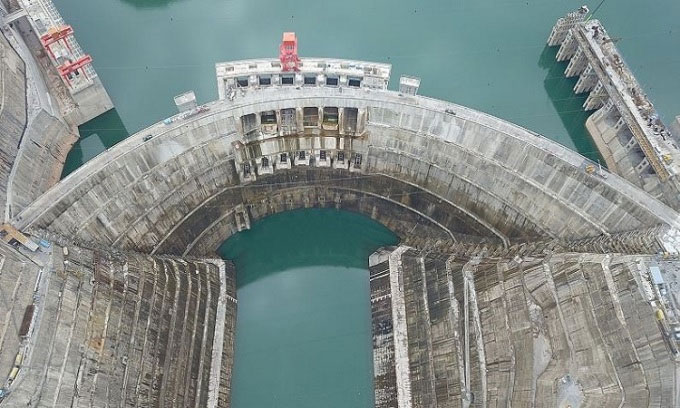Engineers are utilizing a range of advanced technologies to ensure safe operations for the world’s second-largest hydropower project, the Baihetan Hydropower Station.
Located on the Jinsha River, a tributary of the upper Yangtze River in southwestern China, Baihetan Hydropower Station is the largest and most complex project currently under construction globally. The station is equipped with 8 generating units on each side of the dam, producing a total of 16 million kWh. As of the end of September 2022, 12 generators have been put into operation.

Baihetan Hydropower Station in Yunnan. (Photo: CFP)
Once completed, Baihetan will be the second-largest hydropower dam in the world by total capacity, second only to the Three Gorges Dam in Hubei Province, central China. It is estimated that the electricity generated by Baihetan will save 19.68 million tons of coal, equivalent to reducing 51.6 million tons of CO2, significantly contributing to China’s carbon neutrality goal by 2060.
Engineers are employing satellite positioning technology to ensure accuracy in construction operations. The BeiDou satellite navigation system developed by China operates at an altitude of 20,000 km above Earth, monitoring the concrete pouring process and ready to alert for even the smallest unusual movements of the equipment used to pour 8 million tons of concrete into the 289-meter high dam. High precision is essential to ensure this arch dam can withstand water pressure of up to 16.5 million tons. The arched top of the dam extends over 700 meters. The dam is also designed to withstand earthquakes as it is located in one of China’s seismic zones.
Two main challenges in the construction process are controlling the temperature of the concrete and preventing even the smallest cracks on the surface. “The dam construction process requires pouring a large volume of concrete. The hydration reaction of the cement in the concrete generates heat, raising the temperature of the concrete after pouring,” said Sun Minglun, an engineer in the construction team. “Without effective temperature control, cracks are inevitable.”
Sun and his team are using a special type of cement mix that releases minimal heat to construct the Baihetan dam and reduce the risk of thermal cracking. The project opens up the potential for wider use of low-heat cement, according to Zhang Chaoran, former chief engineer at the China Three Gorges Project Corporation.
The 16 generators installed beneath the dam also utilize the most advanced technology. The turbines are produced using smart digital technology and are precise to the extent that their axial vibrations are only the width of a hair. Tens of thousands of sensors are installed in the dam body, collecting real-time data on temperature, pressure, environment, and the concrete pouring process. Technicians can adjust operations based on this information to ensure optimal dam performance.
The construction of the Baihetan dam has a cost of nearly 24 million USD for smart construction technology, according to Xu Weilin, a member of the Chinese Academy of Engineering. He stated that digital simulations and data feedback technology are continuously monitoring the condition of the dam.
According to Global Times, the super hydropower station located on the Jinsha River, an upstream tributary of the Yangtze River, has a total construction cost of 220 billion yuan (34.14 billion USD).


















































